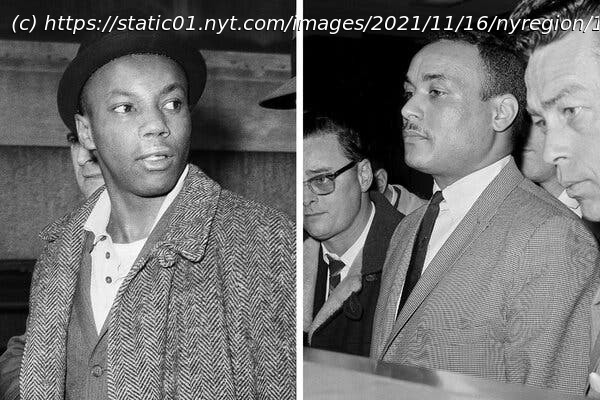The assassination was one of the most painful moments of the civil rights era. But the criminal case that followed was plagued by problems.
The assassination was one of the most painful moments of the civil rights era. But the criminal case that followed was plagued by problems. A timeline of major events in the case since Malcolm X’s death. This is who scholars believe really killed Malcolm X. What we know about Malcolm X’s assassination. A new witness supports the original alibi of one of the wrongfully convicted men. Al Sharpton calls exonerations in Malcolm X case a ‘strange and perverted irony.’ Two of the men cast as the assassins of Malcolm X in 1965 are set to have their convictions thrown out, after an investigation found that the government withheld crucial evidence about one of the most notorious murders of the civil rights era. The Manhattan district attorney, Cyrus R. Vance Jr., said he plans to file a court motion on Thursday acknowledging that the two men, who are now known as Muhammad A. Aziz and Khalil Islam, did not get a fair trial. At an afternoon hearing, prosecutors will join with lawyers for the two men in asking a judge to vacate their convictions, he said. The move follows a 22-month review conducted by defense lawyers and Manhattan prosecutors who concluded that the men had been wrongfully convicted. The investigation revealed documents that showed the district attorney’s office, the Federal Bureau of Investigation and the New York Police Department failed to examine key information and did not disclose accounts of witnesses and informants that might have helped to exonerate the men. Instead, Mr. Aziz and Mr. Islam, Black Muslim men then known as Norman 3X Butler and Thomas 15X Johnson, each spent more than 20 years in prison for the murder of Malcolm X, a hustler-turned-minister who became an icon of the civil rights movement and was shot to death inside a crowded Harlem ballroom. For decades, the men have maintained their innocence. And Mujahid Halim, a third man who was convicted in the assassination after he confessed on the witness stand, has steadfastly denied that Mr. Aziz and Mr. Islam were involved. But the men’s appeals were denied, and their convictions were ultimately upheld in the late 1970s. The eyewitnesses whose sometimes conflicting testimony and questionable identifications of the men were the only evidence of their involvement that day are all dead. Proving the men’s actual innocence 56 years later was not possible, investigators said. The reviewers were also unable to pin the crime on four other men who Mr. Halim said were his co-conspirators. Nor did they resolve bigger mysteries about who ordered the assassination, which came after Malcolm X’s fraught split with the Nation of Islam. The idea that Mr. Islam, who died in 2009 at the age of 74, and Mr. Aziz,83, were wrongfully convicted has long been clear to scholars of Malcolm X’s life and death, who have backed calls from his family for the case to be reopened. That possibility went unexamined by the authorities until last year, when the Manhattan district attorney, Cyrus R. Vance Jr., agreed to review the case ahead of the release of a documentary series, “Who Killed Malcolm X?” Mr. Vance’s Conviction Integrity Unit examined accounts and documents featured in the series, books and blogs asserting that law enforcement authorities knew the true identities of the perpetrators, particularly the man who historians believe to have fired the fatal shotgun blast. The probe also unearthed documents revealing that officials failed to disclose the presence of undercover police officers in the ballroom, as well as descriptions of the gunmen by informants and witnesses that corroborated Mr. Halim’s detailed account of the crime. The omissions went directly to the identity question at the heart of the trial, the panel found. — Ashley Southall Since the assassination of Malcolm X in 1965, uncertainties have plagued historians and scholars, and questions about key details of the case have lingered. Here is a timeline: Feb.21,1965 Malcolm X was killed as he addressed a crowd of roughly 400 people at the Audubon Ballroom at Broadway and 165th Street in Washington Heights. He was pronounced dead later that day. March. 10, 1965 Mujahid Abdul Halim, a member of the Nation of Islam, was arrested as he fled the ballroom. (He was known as Talmadge Hayer at the time and later as Thomas Hagan.) Within two weeks, two other men were arrested and later indicted in the killing: Muhammad Abdul Aziz (formerly Norman 3X Butler) and Khalil Islam (also known as Thomas 15X Johnson). Feb.28,1966 The trial over Malcolm X’s killing began on Jan.22, and all three men took the witness stand to deny the accusations. But several weeks later, Mr. Halim testified a second time, telling jurors that he had been involved in the murder and that his two co-defendants were innocent. He declined to name the real killers. Still, the jury convicted all three men, and they were later sentenced to 20 years to life in prison. 1977 to 1978 Mr. Halim filed two affidavits between 1977 and 1978 that detailed the logistics of the killing and reasserted his claim that his two co-defendants were innocent. He gave partial names of four members of a Nation of Islam mosque in Newark, N.
Home
United States
USA — Science Live Updates: Reaction to the Exoneration of 2 Men Convicted of Malcolm...






